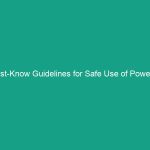Good Morning Team!
Today, we are going to talk about a crucial topic that affects all of us in our daily operations: Essential Power Tool Safety Guidelines. Understanding these guidelines is vital for maintaining a safe working Environment and protecting ourselves and our colleagues from potential Hazards. Power tools are incredibly useful, but they also come with risks that we must manage effectively.
Understanding Essential Power Tool Safety Guidelines
So, what exactly are Essential Power Tool Safety Guidelines? These are a set of practices and Procedures designed to minimize the risks associated with the use of power tools. Whether you’re using a drill, saw, or grinder, adhering to these guidelines can make a significant difference in preventing accidents and injuries.
Power tools can enhance productivity, but they also pose serious risks if not used correctly. Misusing power tools can lead to severe injuries, including cuts, burns, and even amputations. It’s crucial to understand that these guidelines are not just recommendations; they are essential for ensuring your safety and the safety of others.
One common misconception is that power tools are inherently safe if you are experienced. Experience does not eliminate the risks associated with power tools. Regardless of your skill level, following safety guidelines is non-negotiable.
Key Hazards, Risks, and Safety Considerations
Let’s dive into some specific hazards and risks associated with power tools:
- Mechanical Hazards: Rotating parts, sharp edges, and flying debris can cause injuries.
- Electrical Hazards: Improper use can lead to electric shocks or Fires.
- Noise Hazards: Prolonged exposure to loud tools can lead to hearing loss.
- Environmental Hazards: Working in wet or unstable conditions can increase risks.
Ignoring these safety protocols can lead to serious consequences. For example, a lack of proper guarding on a saw can result in accidental cuts, while using a tool with frayed cords can lead to electrical shocks. It’s essential to recognize these risks and take them seriously.
Best Practices, Procedures, & Actionable Advice
Here are some practical tips and step-by-step procedures to follow when using power tools:
1. Inspect Tools Before Use
Always check your tools before using them. Look for any signs of damage, such as frayed cords or missing safety guards. If you find any issues, do not use the tool and report it to your supervisor.
2. Wear Appropriate Personal Protective Equipment (PPE)
Make sure to wear the necessary PPE, including:
- Safety Goggles to protect your eyes.
- Ear protection to prevent hearing damage.
- Gloves to protect your hands.
- Steel-toed boots to safeguard your feet.
3. Follow Operating Procedures
Always follow the manufacturer’s instructions for operating power tools. If you are unsure how to use a tool, ask a supervisor or a more experienced colleague for guidance.
4. Keep Your Workspace Organized
A cluttered workspace can lead to accidents. Ensure that your work area is clean and that tools are stored properly when not in use. This practice minimizes the risk of tripping hazards and allows for better focus while using tools.
5. Use Tools for Their Intended Purpose
Never use a power tool for a task it was not designed for. For instance, using a drill as a hammer can damage the tool and pose serious safety risks.
6. Stay Focused and Avoid Distractions
Concentrate on the task at hand. Avoid talking to others or using your phone while operating power tools. Distractions can lead to accidents.
7. Keep Hands and Body Clear
Always keep your hands and body out of the tool’s path. Use push sticks or other devices to guide materials instead of your hands.
8. Turn Off Tools When Not in Use
Make it a habit to turn off and unplug tools when you are finished using them or when you need to change accessories.
Real-World Examples
Let’s look at a couple of real-world incidents that illustrate the importance of following these safety guidelines:
In one case, a worker suffered a severe hand injury because they were not wearing gloves while using a rotary tool. The tool slipped, and their hand came into contact with the cutting surface. If they had adhered to safety protocols and worn gloves, the injury could have been prevented.
In another incident, a worker ignored Electrical Safety by using a tool with exposed wires. This led to an electrical shock that could have been fatal. Always ensure that tools are in good condition and suitable for the task.
Regulations, Standards, and Compliance
It’s essential to be aware of the Regulations and Standards set forth by OSHA (Occupational Safety and Health Administration) and other relevant organizations. These standards are designed to protect you and your colleagues by ensuring safe working conditions.
For example, osha regulations require that all power tools are maintained properly, and employees must be trained in their safe use. Compliance with these regulations is critical—not only for your safety but also for the safety of your coworkers. Failure to follow these guidelines can lead to severe consequences, including fines and increased accident rates.
Employee Engagement & Discussion
Now, let’s open the floor for discussion. I’d like to hear your thoughts. What safety challenges have you encountered related to power tools? Sharing your experiences can help us all learn and improve our safety practices.
Additionally, feel free to share any tips you have for using power tools safely. Remember, safety is a team effort, and your input is invaluable.
Conclusion & Key Takeaways
To wrap up, let’s summarize the key points we discussed:
- Always inspect tools before use.
- Wear appropriate PPE at all times.
- Follow the manufacturer’s operating procedures.
- Keep your workspace clean and organized.
- Stay focused and avoid distractions while using tools.
By following these Essential Power Tool Safety Guidelines, we can create a safer work environment for ourselves and our teammates. Remember, safety should always be our top priority. Thank you for your attention and commitment to safety!


